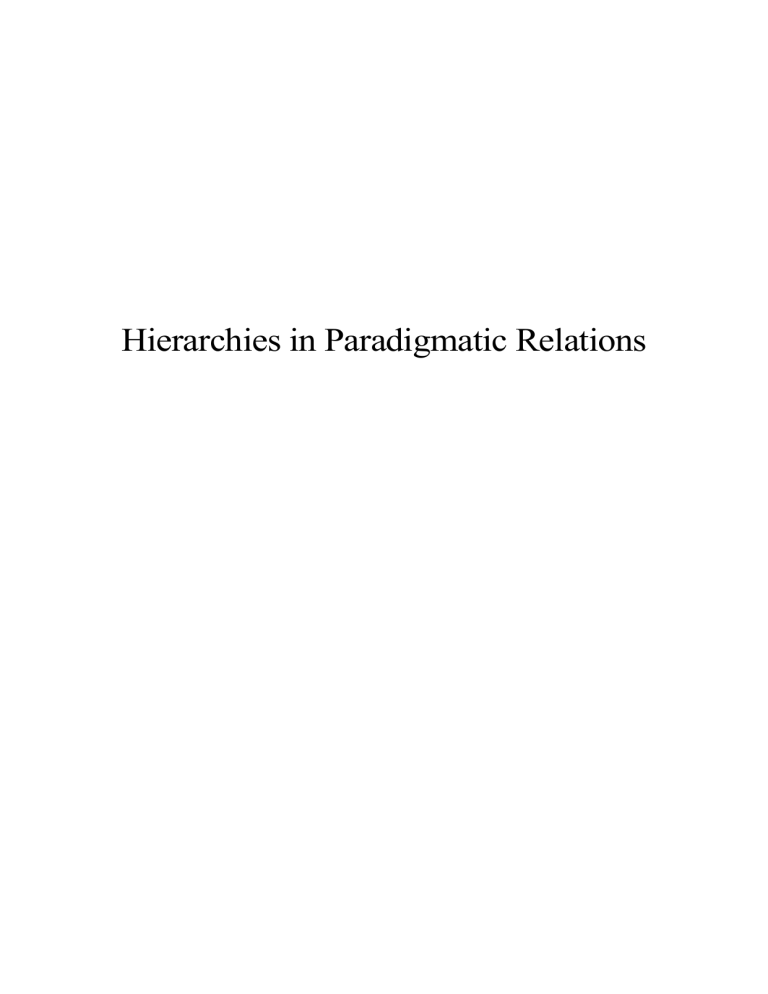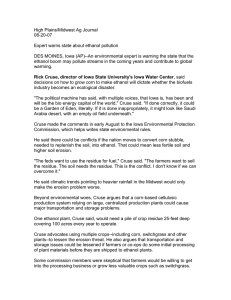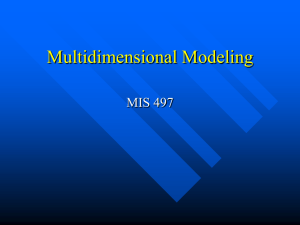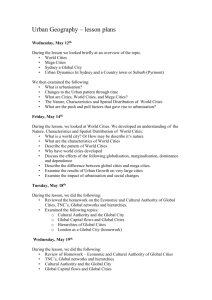
Hierarchies in Paradigmatic Relations Contents I. Introduction ............................................................................................................................. 4 II. Paradigmatic relations ........................................................................................................... 4 a. What are paradigmatic relations ......................................................................................... 4 b. The difference between the paradigmatic relations of inclusion and exclusion ................. 4 III. Hierarchies ........................................................................................................................... 4 a. Relation of dominance and relation of difference............................................................... 5 i. Asymmetry and symmetry ............................................................................................... 5 ii. Catenary relations ........................................................................................................... 5 b. Transitivity.......................................................................................................................... 5 c. Differentiability .................................................................................................................. 6 d. Incompatibility.................................................................................................................... 6 IV. Hyponymy ............................................................................................................................ 6 b. Taxonymy and natural taxonomies..................................................................................... 7 c. Transitivity .......................................................................................................................... 7 d. Anomalies ........................................................................................................................... 7 V. Meronymy ............................................................................................................................. 8 a. Parts and pieces ................................................................................................................... 8 b. Prototype features ............................................................................................................... 8 c. Canonicity and facultativity ................................................................................................ 9 b. Transitivity.......................................................................................................................... 9 i. Functional domain ........................................................................................................... 9 ii. Attachments .................................................................................................................. 10 VI. Comparison of hyponymy and meronymy......................................................................... 10 a. Entailment ......................................................................................................................... 11 b. Transitivity........................................................................................................................ 11 VII. Conclusion ........................................................................................................................ 11 2 Bibliography: ............................................................................................................................ 13 3 I. Introduction Different languages use different words to express the same meaning. This is shown by the difference between a lexical unit and a conceptual unit. Lexical units are words themselves, whereas conceptual units are the meanings behind the words. Meanings do not exist in isolation, separately from one another, but establish different relations between themselves. These relations generate different organizational schemata which are part of speakers’ linguistic knowledge, whether they are aware of it or not. One of these schemata are hierarchies, an organizational structure with different levels. Hierarchies are used to represent family trees, evolution of organisms, but also specific relationships between conceptual units. The topic of this paper are hierarchies in paradigmatic relations, which means that this paper will look at the way conceptual units are organized into hierarchies. II. Paradigmatic relations a. What are paradigmatic relations Paradigmatic relations belong to the class of sense relations, which means they are established between meanings (cf. Cruse 2011: 129), that is between discrete conceptual units. Even when lexical units have more than one meaning associated with them, only one conceptual unit of that lexical unit enters into a specific relation with another conceptual unit. Paradigmatic relations are established between conceptual units that are interchangeable in a given sequence (cf. Matthews 2007: 285). This means that units that are connected by the paradigmatic relations can be inserted in the same position of a certain sequence. b. The difference between the paradigmatic relations of inclusion and exclusion There are different kinds of paradigmatic relations, so exchanging conceptual units that are related paradigmatically can create sentences with the same meaning, but also with different meanings. The two main types of paradigmatic relations are those of identity and inclusion and of opposition and exclusion. The relations between the conceptual units that change the general meaning of the sentence when exchanged belong to the category of paradigmatic relations of opposition and exclusion, and the relations between conceptual units that can be exchanged without changing the underlying meaning of a sentence are paradigmatic relations of identity and inclusion. III. Hierarchies Hierarchies are particular way in which conceptual units connected by specific paradigmatic relations are organized. They can be either branching or non-branching. In 4 branching hierarchies, there is more than one concept connected to the concept on the higher level, i.e. each concept branches into more than one concept on a lower level. Branching hierarchies sometimes do not branch, but non-branching hierarchies cannot branch at all. (cf. Cruse 1986: 112-113). a. Relation of dominance and relation of difference Relation of dominance and relation of difference are essential to the branching hierarchies. Relation of dominance is the vertical relation: the nodes on higher levels in hierarchies dominate the nodes on the lower levels. It connects elements on different levels of a hierarchy. Relation of difference is the horizontal relation that connects nodes on the same level in a hierarchy, the sister-nodes. This means that sister nodes cannot be the same. If A branches into B and C, then B and C must be different from one another. These two relations must be constant in well-formed hierarchies. (cf. Cruse 1986: 113) i. Asymmetry and symmetry Relation of dominance cannot be established without asymmetry. An asymmetric relation has a directional character. This means that if A dominates B, the relation of A to B cannot be the same as the relation of B to A. The relation changes with the change of direction. (cf. Cruse 1986: 113) For example, if A is warmer than B, than B cannot be warmer than A. This is opposite of symmetry relations, which hold both ways. A typical symmetry relation is ‘is similar to’. If A is similar to B, then B is similar to A (cf. Cruse: 1986:113). This kind of relation does not allow the create of dominance. The relation between two nodes, or conceptual units, must be asymmetric so that the relation of dominance can be established. ii. Catenary relations A relation of dominance also requires the relations to be catenary. Relations are catenary when the relation between two elements on two consecutive levels of hierarchy can be passed vertically. For example, in a family tree, the relation ‘is a child of’ can be established between any two vertically connected elements. If ‘A is a child of B’, then ‘B’ can be a child of ‘C’. The relation ‘is married to’ is non-catenary, because if ‘A is married to D’, then ‘D’ cannot be married to ‘E’, but only to ‘A’ (in monogamous systems) (cf. Cruse 1986: 112-113). A well-formed hierarchy must realize catenary relations. b. Transitivity In a hierarchy, the relation of dominance can be transitive or intransitive. If the relation is transitive, then the same kind of relation is established between one superordinate 5 element and elements dominated directly and indirectly. If A dominates B, and B dominates C, then the same kind of relation is established between A and, B and C, and A and C if the relation is transitive. For example, if A is longer than B, and B is longer than C, then A is longer than C. An intransitive relation is ‘is father to’ because if A is father of B, and B is father of C, A is not father of C. (cf. Cruse 1986: 113). The relations in hierarchies can be either transitive or intransitive, because the relation of dominance is established in each case. c. Differentiability Branching hierarchies must be differentiable. This means that “a relation must be capable of being directed along mutually exclusive pathways in an indefinite number of successive stages” (Cruse 1986: 115). Unlike the relation of dominance, which is a requirement for any kind of hierarchy, the differentiability is a characteristic of branching hierarchies only. The non-differentiable are non-branching hierarchies. In branching hierarchies, for an element at each level it must be possible to differentiate into different elements at lower levels. d. Incompatibility Incompatibility belongs to the paradigmatic relations of opposition and exclusion, and is established between elements that are dominated by the same element. Incompatibles are classes that share no mutual members (cf. Cruse2011: 151). The term ‘fruit’ dominates ‘apple’, ‘pear’, ‘orange’, ‘banana’, and many other terms. If something is a banana, than it cannot be an apple, a pear, or an orange. These four classes share no mutual members. Elements on that are directly dominated by the same element must be incompatibles in branching hierarchies. IV. Hyponymy Hyponymy is a paradigmatic relation of identity and inclusion, “concerned with the labelling of sub-categories of a word’s denotation” (Griffiths 2006: 47). The daughter nod is hyponym, and the mother nod is superordinate. So if an A is a type of a B, then A is a hyponym of B, and B is a superordinate of A. Hyponyms of the same superordinate are called co-hyponyms, and the relation established between them is co-hyponymy (cf. Kreidler 1998: 93). Co-hyponymy is subject to incompatibility, i.e. co-hyponyms must be different from one another, they cannot share members. 6 b. Taxonymy and natural taxonomies Taxonymy, a “sub-species of hyponymy”, is a sense relation which is “the key to a taxonomic lexical hierarchy” (Cruse 1986: 137). It is the true “kind/type of” relation, whereas some other hyponomies may not fit into this frame. For example, ‘A poodle is a kind of dog’ and ‘A tulip is a kind of flower’ are normal sentences, but ‘?A kitten is a kind of cat’ and ‘?A spinster is a kind of woman’ are not. “A taxonym must engage with its superordinate in a particular way, by further specifying its core characteristic. (Cruse 2011: 137). A hyponym of a superordinate that fits into a frame ‘is kind/type of’ is called a taxonym, and the relation between taxonyms of the same superordinate is co-taxonymy (cf. Cruse 1986: 137). Just like in co-hyponymy, co-taxonyms are incompatibles. Natural or folk taxonomies are those frequently used in language. Usually they have no more than 5 levels, but often have even fewer, which may appear as a limitation, “exhibit[ing] general linguistic and cognitive constrains”. More specialist taxonomies have more levels, but everyday language does not appear to have the need for more than five levels. (cf. Cruse 1986: 1945-46). c. Transitivity Regular hyponymy is a transitive relation, but taxonymy appears to be intransitive. If spaniel is a dog, then spaniel is also an animal, but it seems misleading to say that spaniel is a type of animal (cf. Cruse 1986: 165). However, even hyponymy can have transitivity breakdowns. For example: A car seat is a type of seat. A seat is a type of furniture. * A car seat is a type of furniture. (Cruse 2011: 136) One way to explain this is with the requirement for hyponyms to be prototypical representatives of their superordinates if the relation is to be transitive. The dynamic construal approach says that there are two different construals (or conceptual units), in this case for the lexical unit ‘seat’, and that only one of those is a hyponym of ‘furniture’ (Cruse 2011: 136137). Regardless of the explanation for the lack of transitivity, it is clear that hierarchies can be well formed even without their relations being transitive. d. Anomalies Taxonomies are not all well-formed so some may exhibit gaps. They often have covert categories. This means that taxonyms are dominated by a superordinate that does not have a lexical form. They occur more frequently at the higher levels of hierarchies, where the 7 concepts are more general (cf. Cruse 1986: 147-8) Another kind of gap is the lack of evidence that a node exists at all. The speaker intuitively knows that the covert category exists so they should be somehow included in the hierarchy, but the nodes that lack intuitive or linguistic evidence should therefore not be represented in the hierarchy. Another gap is concerned with male and female members of different species. The name for the male member is often used to denote both male and female. (Kreidler 1998: 95) This is the case where a lexical unit has more than one conceptual unit connected to it. For example, a mare is a female horse, a stallion is a male horse, but ‘horse’ can also denote a female horse. In the same way, ‘dog’ refers to the species of animals, but also to the male member of that species, wher V. Meronymy Meronymies are another type of branching hierarchies. The relation established between elements in meronymic hierarchies is the ‘part-whole’ relation. If two conceptual units are related by the meronymy, then one is part of the other. The prototypical meronymy is the relation established among the body parts (cf. Cruse 1986: 157). A meronym is a part of a holonym, and the relation between two sister meronyms is co-meronymy. (cf. Cruse 2011: 137). Rather than a single relation, meronymy can be defined as “a numerous family of moreor-less similar relations” (Cruse 1986: 160). However, to be a meronymy, all these similar relations must fit into the frames ‘is a part of’ and ‘has’. So ‘finger is a part of hand’ and ‘hand has fingers’ proves the relation of meronymy between finger and hand (cf. Cruse 1986: 161). Two conceptual units that are related by meronymy fit into two very specific frames. a. Parts and pieces Meronymy is the relation between ‘wholes’ and its ‘parts’, not ‘pieces’. Both pieces and parts have topological stability, spatial continuity and determinate topological relationships with their wholes and with their sister-parts. However, only parts show autonomy, motivated, non-arbitrary boundaries, and determinate function with respect to the whole. Whereas parts are differentiated enough to have different names, pieces do not show such consistency and hence do not qualify for lexical labels (cf. Cruse 1986: 158-159). b. Prototype features Some parts can be prototypical of certain wholes, whereas other may even be optional. Compared to hypnymy, the case of borderline are much more frequent in meronymy. It also happens that informants are unsure whether something is meronym of a certain holonym, or 8 they might disagree. Certain features can be deduced that contribute to ‘goodness of exemplar’: necessity, integrality, discreteness, motivation, and range, phase, and type as part of congruence. A holonym should need the meronym for well-formation, meronyms should be rather integral to their holonyms, and clearly divided from their sister parts, and have have a clear functions. Typical meronyms are less general than their holonyms, exist simultaneously with their holonyms and are of the same ontological type as the holonyms. (Cruse 2011: 138-140). c. Canonicity and facultativity Both meronyms and holonyms can be either canonical or facultative. Canonical meronyms and holonyms are required for well-formation or well-functioning of an entity, but the existence or presence of the facultative ones is optional. Canonicity and facultativity can be either unilateral or bilateral. A meronym A may require a holonym B, but this holonym B does not require the meronym A. In this case canonicity are facultativity are unilateral. When both meronym and holonym are either facultative or canonical, this is the case of bilateral canonicity or facultativity. The stricter test of meronymy requires bilateral canonicity. For example, a finger is a bilateral canonical meronym of hand (cf. Cruse: 1986: 162). So there is a variation in the relationships between different holonyms and its meronyms. b. Transitivity i. Functional domain Meronymy is complicated to define in terms of transitivity. The ‘failure’ of transitivity is linked to the notion of functional domain (Cruse 1986: 165). Every meronym has a function with respect to some whole. Its functional domain is the more inclusive element within which it functions (Cruse 1986: 166). There are two dominant aspects of functional domain to be noted: 1) Functional domain may be restricted or generalized. In the case of the door handle, it is restricted, because the handle serves to move and thusly open the door, but it has no direct function to the house of which this door is a part. When restricted, the functional domain does not transfer upwards in the hierarchy. 2) Many functional domains are already determined in the meanings of the parts, but there are also parts whose functional domain is determined only in specific contexts. This is why ‘the house has a handle’ does not automatically refer to the door handle, but ‘the house has (porcelain) door handles’ is a perfectly normal sentence. 9 Each part has its own functional domain, which changes throughout the hierarchy, so the meronymy is not necessarily a transitive relation (Cruse 1986: 166-167). ii. Attachments The failure of transitivity in meronymy is also caused by attachments, one type of parts. Just like integral parts, attachments must fit into the general frames of meronymy: ‘is a part of’ and ‘has’. But unlike integral parts, which are truly a part of a larger entity, attachments are only attached to a larger entity called stock. So the wholeness of the whole is not damaged if an attachment is missing. (Cruse 1986: 167) The transitivity failure occurs because something that concerns the attachment, does not necessarily concern the whole too. VI. Comparison of hyponymy and meronymy The most obvious mutual characteristic of the two relations is the hierarchical organization. The lower nodes are dominated by the higher nodes. The two relations can even be seen as two realizations of one underlying organizational principle (cf. Cruse 1986: 179). Hyponymy, especially taxonymy, can be transformed into meronymy, which suggest a close relationship between the two relations. If meronymy is defined by the frames ‘is a part of’ and ‘has’, then hyponymy can be transformed into ‘the superordinate A has hyponyms B, C, and D’ and ‘hyponyms B, C, and D, are a part of the superordinate A’. Furthermore, both relations have a kind of sub-division, which includes inclusion and exclusion, and maximization of internal cohesiveness and external distinctiveness (cf. Cruse 1986: 179). Members that belong to the same class have certain degree of resemblance, and parts are cohesive in terms of physical integrity; members belonging to different classes do not share certain traits and parts realize distinctiveness by being physically unconnected (cf. Cruse 1986: 179). Meronymy and hyponymy differ in the way they refer to extra-linguistic facts (cf. Cruse 1986: 178). Whereas hyponymy is about the sub-groups, meronymy is about the parts and the wholes they belong to. The classes denoted by taxonymy form a hierarchy that corresponds to the lexical hierarchy. On the other hand, the classes denoted by meronymy are not in hierarchical relation. The hierarchy is based on the way individual parts are related, which makes meronymy more closely linked to reality. Cruse concludes that “corresponding to a taxonomix hierarchy is a hierarchy of classes, whereas corresponding to a part-whole hierarchy there is a class of hierarchies” (Cruse 1986: 178). 10 a. Entailment In hyponymy, a hyponym entails the superordinate. If ‘apple’ is a hyponym of ‘fruit’, then if something is an apple, it is also a fruit. This is not true for the opposite direction (cf. Kreidler 1998: 93). The entailment pattern, however, changes if certain aspects change. If the sentence is negative, the entailment switches direction. If B is a hyponym of A, then ‘X is not an A’ entails ‘X is not a B’, but ‘X is not a B’ does not entail ‘X is not an A’. If an entity is not a poodle, it does not mean it is not a dog, but if some entity is not a dog, it entails that it is not a poodle either (cf. Griffiths 2006: 47). In meronymy entailment works opposite than in hyponymy. A holonym entails a meronym, but meronym does not necessarily entail the holonym. This is because “parts can exist in the absence of the larger whole” (cf. Griffiths 2006: 43). For example, wheels exist without a bike, but a bike without wheels would be considered incomplete. So entailment goes in different directions in meronymy and hyponymy. b. Transitivity As concluded before, transitivity is an optional characteristic of hierarchies. It may seem logical that meronymy and hyponymy are transitive relations: if A is a kind of B, and B is a kind of C, then A is a kind of C; and if X is a part of Y, and Y is a part of Z, then X is a part of Z. But meronymy and hyponymy are conceptual and not lexical relations, so transitivity failures are rather frequent phenomenon. VII. Conclusion Hierarchies are a specific way conceptual units are connected and organized. The units on the higher levels are usually more general and include in their meaning the units on the lower levels, which categorizes hierarchies as paradigmatic relations of identity and inclusion. There are, however, also the relations of incompatibility and differentiability between sister nodes, which belongs to the paradigmatic relations of opposition and exclusion. These two relations can be described as relation of dominance and relation of difference respectively, because the higher nodes dominate the lower ones, and the sister nodes must be different from one another. Relation of dominance can only be established if the relation between two conceptual units is asymmetric and catenary. Asymmetric relation changes with the direction of relation, and a catenary relation is the one that can be established on two consecutive levels that share one member. Branching hierarchies differ from the non-branching ones because each node branches into more than one node on the lower level. It may be logical to conclude 11 that the vertical relations in hierarchy are transitive, but transitivity is an optional feature of hierarchies. The relations are established between conceptual units, not lexical, so the distance between units may weaken the explicit relation. Two main types of branching hierarchies are hyponymy and meronymy. Hyponymy is a relation established between a group and its subgroups. The most common kind of hyponymy is a taxonymy, relation with the framework “A is a kind/type of B”. The more general term is ‘superordinate’, and its subgroups are called ‘hyponyms’, or “taxonyms” in taxonymy. The sister nodes are ‘co-hyponyms’ or ‘co-taxonyms’. Taxonymy can have certain anomalies, the most prominent ones are covert categories and the lack of difference between the lexical unit for the male member of the group and the group in general. These instances confirm that taxonymy is a conceptual relation, because there is the difference in meaning and sense of a separate node, although there is no (distinct) lexical unit to mark the difference. Meronymy is a relation established between a whole and its parts, the whole being called holonym and its parts meronyms. The relation between sister nodes is co-meronymy. Both relations are characterized by entailment, but in different directions. In hyponymy, a hyponym entails its superordinate in a positive sentence, whereas a holonym entails its meronyms in meronymy. The entailment direction changes for taxonymy if the sentence is negative, which is, however, not the case in meronymy. The two relationships exhibit a certain degree of similarity – they have all the characteristics of branching hierarchies, but are essentially different enough to be described as two different kinds of branching hierarchies. Words: 3499 12 Bibliography: Cruse, Alan (2011). Meaning in Language: An Introduction to Semantics and Pragmatics. Oxford: OUP. Cruse, D.A. (1986). Lexical Semantics. Cambridge: Cambridge University Press. Griffiths, Patrick (2006). An Introduction to English Semantics and Pragmatics. Edinburgh: Edinburgh University Press. Kreidler, Charles W. (1998). Introducing English Semantics. London: Routledge. Matthews, P. H. (2007). Concise Dictionary of Linguistics. Oxford: Oxford University Press 13





